#Volkswagen Transporter-Kombi
Text
Utilizing Access Commercials Vehicles, Transform Your Fleet
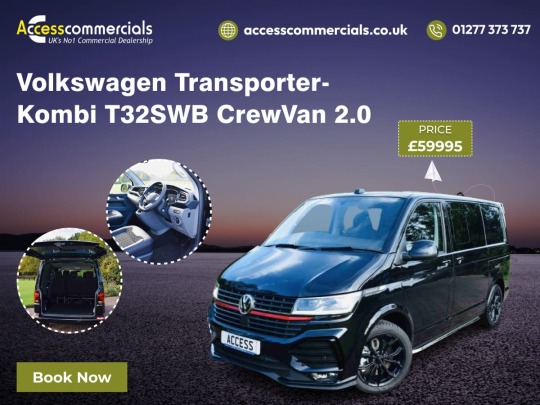
Access Commercials stands as the top choice for reliable vehicle acquisitions and rentals. Offering a wide range, including cars, vans, minibuses, and temperature-controlled trucks, they reign as the premier destination for businesses. Whether you're looking to purchase or lease, Access Commercials ensures your company's vehicle needs are met with confidence and excellence.
Follow us at -
.
Facebook - https://www.facebook.com/AccessCommercialsUkLtd
Twitter - https://twitter.com/Essexvans
You tube - https://www.youtube.com/channel/UC0qotmK-3tKiQZfI2ZyN2Dg/videos
Instagram - https://www.instagram.com/accesscommercials/
#Access Commercials#Commercial Vehicles Dealers#Commercial Cars#Commercial Vehicle Sales#Used Commercial Vehicles#Volkswagen Transporter-Kombi#Vehicles For Rent
0 notes
Text

Commissioned work, T1 Transporter
#auhapwrd#volkswagen#vw#vw bus#vw beetle#kombi#vwt1#volkswagent1#minibus#mini bus#volkswagen t1#transporter#illustration#car illustration#car#3dart#jdmcars
3 notes
·
View notes
Text
0 notes
Text
What Happened to the VW Bus? Is It Coming Back?
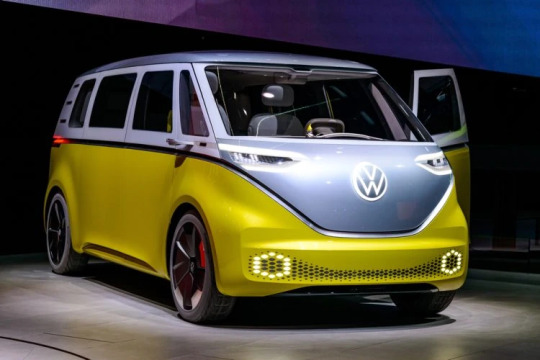
Actually, nothing happened to the VW bus. It just became less popular, temporarily, in the United States. And yes, it is coming back in a big way!
After the 1970s, the U.S. shut down VW bus manufacturing since the popular van was no longer was able to meet new safety and emissions standards. Production continued in Brazil, however, until 2014, when Brazil enacted new standards that the current model of the bus couldn’t meet. When that happened, the German production factory shut down its production after 63 years – the longest running time of any vehicle ever.
Now, many people are excited to learn the Volkswagen Bus is coming back next year, in 2024 – as the ID. Buzz (yes, that is its name!). It’s electric, eclectic and brings back a hint of the hippie movement psychedelic nostalgia with its neon colors: tangerine, lime, grape and more. Volkswagen is hoping to once again earn the respect and admiration of a new generation of car buyers.
One reason the VW bus became obsolete was its failing safety measures. No matter what you choose to drive, being safely prepared for the road by purchasing affordable car insurance will ensure your favorite vehicle never goes out of style.
The Peculiar History of the VW Bus
Although many people in the U.S. think of the iconic Volkswagen bus as the original hippie van from the 1960s, it has a different association in Europe, where it was born in Germany in the 1940s. Colloquially called the VW Bus in America and the VW Camper in the UK, the Volkswagen bus was modeled after the German Plattenwagen, a vehicle originally made to carry car parts. Dutch businessman, race car driver, winemaker and Olympian Ben Pon, always looking for something new and already selling the hugely popular VW Beetle in the United States, saw the Plattenwagen during a tour of the Volkswagen plant in West Germany one day and the lightbulb went off.
The Beetle paved the way for what was known then as the VW Transporter, later called the Volkswagen Microbus and then, in later years, the Bus. In the 1950s when the Transporter hit the market, buyers could choose from 8 different models, all designed to answer a specific need. Today, there are more than 15 variations of the Transporter (or T models) on the market.
For example, the Kombi VW bus featured removable rear seats so consumers could use the van to carry cargo (and people). A variety of side windows options also made an appearance during these days, with a low-end version offering 11-15 windows spaced around the van and high-end versions offering 23-window VW buses. Early models carried a hard to clean split front windshield, earning it one of many nicknames, “the Splitty.” Volkswagen did away with this unpopular feature, creating a solid front windshield.
In Europe, families and friends used the popular bus for camping trips, as did Americans, who also plastered peace signs all over it and drove it to see Jerry Garcia and the Grateful Dead. Europeans turned it into an ambulance, and everyone used its large interior for deliveries and carting stuff around.
In the 1960s, things began to turn around in the U.S. market when people became more concerned with vehicle safety and emissions – and something known as the chicken tax.
Chicken Tax
The Chicken War started when American farmers adopted poultry factory farming practices in the 1950s. Soon, chicken was being exported to Europe in mind-boggling numbers – which didn’t sit well with German farmers. Feathers flew and, as a result, high tariffs were implemented on imported chicken in Europe.
In America, the United Auto Workers were threatening a strike over the importing of the popular Volkswagen Type 2 pickup truck.
In response to both of the above, President Johnson imposed a 25% tax on imported light trucks. Called the Chicken Tax, it’s still in effect today. The effect on the Volkswagen is, in order to avoid the Chicken Tax, the vehicle cannot be sold as a truck or any kind of commercial vehicle.

Today’s Volkswagen Bus
Today, three different iterations of the VW bus are on the production line at a plant in Hanover, Germany. The model year T6 continues to be built with a van platform but is ceasing production with the new ID. Buzz. This is its last year. The T7 is a medium-sized Transporter with a large cargo area marketed as a plug-in hybrid. And the newest member of this family of unconventional members is the Buzz, due in the U.S. in 2024.
In Europe, the electric Buzz rolled into the market in 2022 and found new categories to master, including as a police car, a school bus, a postal truck and much more. But in America, the Buzz will never climb to the exalted ranks of a service vehicle. The chicken tax took care of that. It will always be a passenger van on these shores.
The Buzz About the Buzz
Let’s talk specifics about this new van that’s supposed to bring us all back to the days of concerts, tie-dye and peace signs. Of course, it is electric. But what other changes will we see?
Appearance: Some people think the new Buzz looks similar to the old Scooby-Doo van. Others think it looks like what might happen if a modern minivan had a baby with a sleek sports car. It certainly no longer has the goofy smile of the old VW Bus. Some people say it looks like an angry cousin.
Mechanics: It’s no longer necessary to carry around the “How to Fix Your Volkswagen for the Complete Idiot” and 3 wrenches. The downside is that a paper clip and a rubber band won’t fix the rear engine until you can get it to a shop. And, gasp, it comes in automatic transmission, too. Staying on top of maintenance will get you further.
Noise and Driving: If you’ve ever driven or ridden in an older VW Microbus, you already know how noisy it was, with bone-jarring shakes and rattles. It may – or may not – make it up that steep hill in the mountains of Colorado. Perhaps try reverse to make it up? Today’s version will have up to 201 horsepower (the original had an HP of two digits). It’s supposed to be much easier to maneuver. You’ve got to wonder if they took out all the fun!
Smart Car: You probably won’t consider the new Buzz as you did its distant little brother or sister. In the 60s, the bus was considered a valuable and friendly member of the family. The Buzz is more like the rather stern computer Hal in “2001: A Space Odyssey” (except for the part where Hal goes crazy and murders the crew). That won’t happen with Buzz, but it may stop you from switching lanes without signaling or flashing colors at you if there’s an obstruction in the road.
Overall, VW is banking on the new trend for electrical vehicles to help it become the world player it once was with the Beetle and the original VW bus in decades past. And although it may cost quite a bit more than the original ($1,800 vs $40,000), there are still fans clamoring to get a piece of yesterday for today.
Protect Your Vehicle Investment with Freeway Insurance
Whether you choose to drive a new electric VW Buzz or you are thrilled to get your hands on the iconic 60s version, having the right auto insurance can help you protect your ride and yourself. At Freeway Insurance, we can find affordable insurance that meets your budget and your needs. To get started, get a quick online quote, give us a call at (800) 777-5620 or stop by one of our convenient locations.
3 notes
·
View notes
Text
youtube
Volkswagen Kombi, a lendária Van Que Marcou Época no Brasil e no Mundo!
Volkswagen kombi, a lendária van; desde seu lançamento na década de 50 a Kombi tem sido um veículo icônico e amado por muitos. Hoje vamos explorar sua história, características únicas e porque a Kombi é uma escolha atemporal e duradoura para muitos proprietários.
Volkswagen kombi, a lendária van e sua história
Ela foi originalmente lançada como uma van de transporte de passageiros. Ao longo dos anos a Kombi evoluiu passando por várias mudanças no design, tecnologia e funcionalidade. No entanto, o design clássico e atemporal da Kombi é reconhecido em todo mundo e continua atraindo proprietários até hoje. Além de ser um veículo de transporte confiável a Kombi também é conhecida por sua versatilidade.
#anovaKombi#carrosantigos#carrosantigosbr#vwkombi#a Kombi#a nova Kombi#carros antigos#charme nostálgico da Kombi#comprar kombi#comprar miniatura#comprar miniaturas#Conheça a lendária VW Kombi#Estilo de vida com a VW Kombi#Evolução da VW Kombi#Fãs da VW Kombi#fãs de Kombi#História da VW Kombi#ID. BUZZ#kombi#Youtube
2 notes
·
View notes
Text
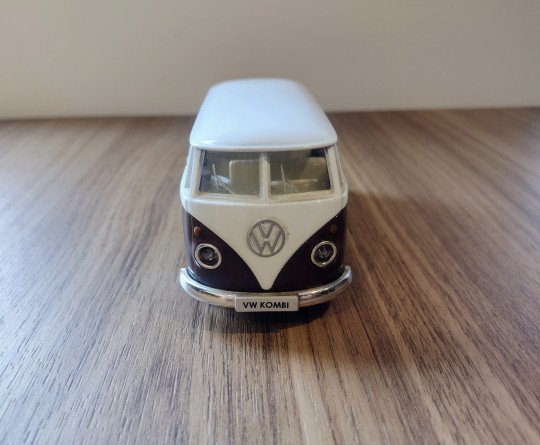
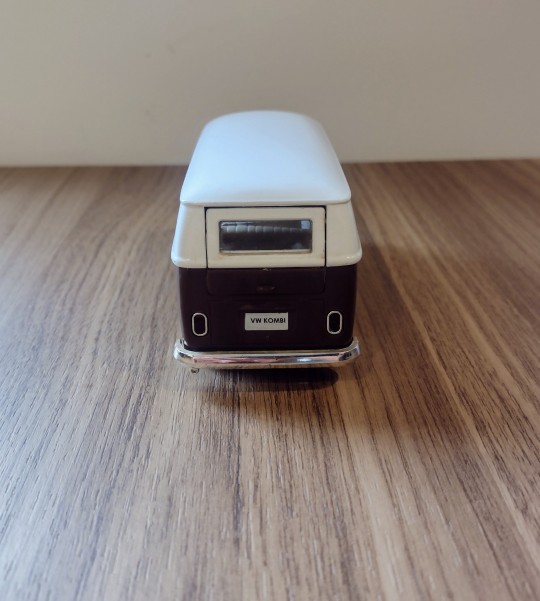
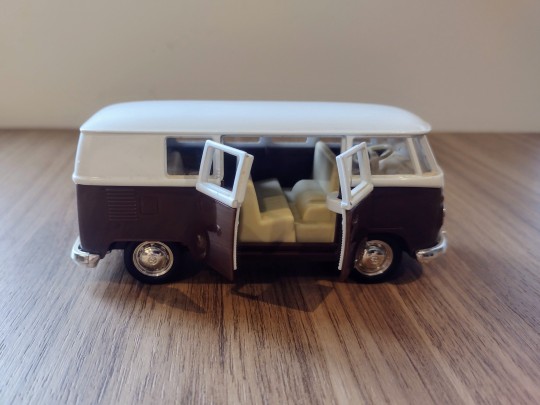



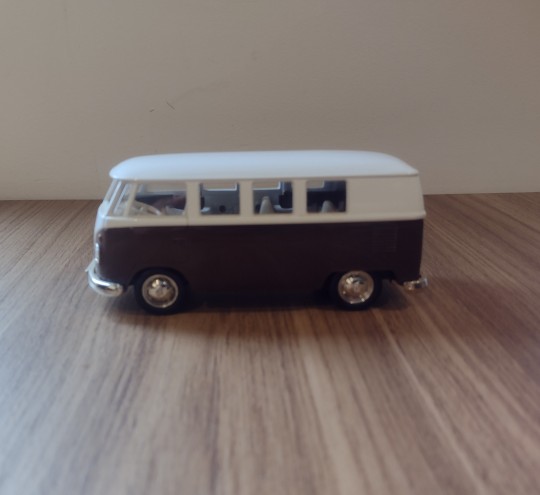
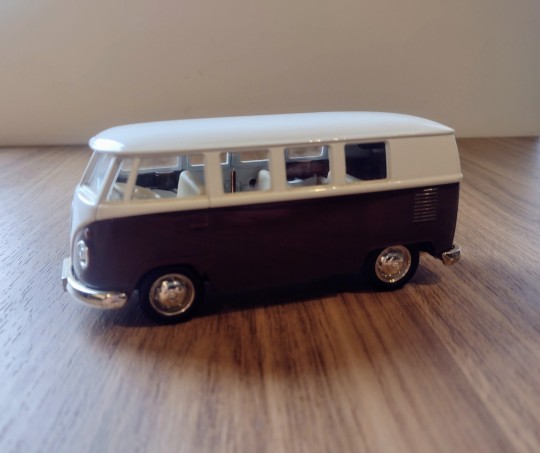
Miniatura Volkswagen Kombi T1 Transporter.
Fabricante Unifortune.
Escala 1:36.
Cor marrom, teto branco e bancos bege.
Materiais metal, plástico rígido injetados, pneus de borracha.
Com fricção.
Abertura de portas lateral e porta malas.
Medidas: 13 cm comprimento x 4,5 cm largura x 5 cm altura.
Item sem uso, estoque antigo.
Ideal para colecionadores e decorações vintage de Barbearia e Garagem.
Artes e Antiguidades
1 note
·
View note
Text
Le grandi auto: Bulli, pullman Volkswagen

Il mezzo perfetto per viaggiare durante una lunga vacanza nelle regioni italiane e non solo...
La storia del Pullman Volkswagen,detto Bulli, cominciò con Ben Pon, importatore olandese del Maggiolino Volkswagen che, durante una visita allo stabilimento Volkswagen di Wolfsburg nell’aprile 1947, si imbattè nel Plattenwagen, un carrello semovente che il personale dell’impianto aveva costruito per uso interno usando un Maggiolino scartato dalla produzione.
Affascinato dall’idea di unire la robustezza meccanica di un’auto leggendaria alla versatilità di un mezzo più capace, Pon provò a schizzare su un foglio le forme del Transporter.
L’idea piacque ai vertici della Volkswagen e nel giro di un anno erano in test i prototipi del Bulli, il mezzo che ha dato vita al concetto stesso di camper.
Per i britannici il Bulli si chiama VW Panelvan, negli Usa è noto come VW Bus, in Sudafrica come Campervan e in Brasile come Kombi, ma in Italia lo si è sempre chiamato minibus Volkswagen oppure Westfalia, dal nome del costruttore dell’allestimento camper.
In Germania a partire dai primi anni Sessanta il Transporter T1, poi T2 col parabrezza in pezzo unico e i vetri delle porte discendenti, è stato prodotto in Brasile, Perù, Sudafrica, Thailandia, Pakistan e Turchia per un totale di oltre 10 milioni di esemplari.
Il successo autentico, e la consacrazione come icona del Bulli, giunse col movimento hippy, infatti a fine anni Sessanta migliaia di pallamano di terza mano, riverniciati a colori vivaci e trasformati in camper con grande inventiva, divennero rapidamente il manifesto di un nuovo stile di vita in libertà a quattro ruote.
Terminata la produzione del Bulli in Brasile a dicembre 2013, dopo che nel resto del mondo si era passati a nuovi modelli con carrozzerie più moderne e trazione anteriore, la passione per il pullman Volkswagen non è minimamente calata, che c’è chi dal 2013 sta usandolo per attraversare tutto il continente americano dal Brasile all’Alaska e chi invece ha ideato un vero e proprio videotutorial su restauro e trasformazione di un Panelvan del 1955, tutto nel segno di una vera icona senza tempo.
Read the full article
0 notes
Text
Bullimania Teil 3 von 10

Allrounder und Arbeitstier. Wie VW den Bulli T1 beworben hat ist aus heutiger Betrachtung teils skurril. Sein Erfolg ein Wunder und wusstet ihr es...?
Heute unterscheiden wir sicher in verschiedene Fan Gruppen beim VW Bulli, welche sich kaum mehr unterscheiden können, als Tag und Nacht. Da gibt es solche, die den Bulli derart umbauen, tieferlegen oder tunen, dass man ihn kaum noch erkennt. Die andere Gruppe versucht die Fahrzeuge möglichst in den Originalzustand zu versetzen. Doch ganz am Anfang seiner Laufbahn wurde der VW Bus, damals noch der T1, als Alleskönner und Arbeitstier beworben.
Da richtete sich Fernsehwerbung speziell an die Landwirte. Der Bulli sollte ihnen endlich das Pferdefuhrwerk ersetzen, ihnen einen wirtschaftlichen Vorteil bieten, um ihre Kunden zu beliefern oder gar zum Transport von Tieren dienen. Wenn man mehrere Personen zur Ernte aufs Feld zu transportieren hatte, wurde einfach eine oder zwei Sitzbänke in den Bus gestellt. Mehr oder weniger gut befestigt waren damals die Sitzreihen im Transportraum.
Heute wäre das nicht mehr vorstellbar und auch völlig unzulässig, den VW Bus in der Form wie damals zu nutzen. In seiner Anfangszeit sah das aber anders aus. Und da VW quasi die alleinige Marktführerschaft hatte, war es auch verständlich, dass der VW Bus sich mehr als gut verkaufte. Bevor die Produktion nach Hannover umzog wurde er anfänglich neben dem VW Käfer produziert und von einigen auch als VW Käfer Kombi wahrgenommen.
Kein Wunder, denn der T1 hatte 1949 viel vom Käfer. So saß beim ersten fahrbereiten Prototyp die Karosse des T1 auf einem Käfer-Chassis. Allerding merkten die VW Entwickler schnell, dass dieses Fahrgestell für die Serie nicht geeignet war und entwickelten einen Hilfsrahmens, welcher am Boden und Karosserie befestigt wurde. Und so entwickelte man am Bulli weiter, übernahm aber dann auch den Motor vom Käfer.
Nachdem man viel vom VW Käfer zu übernehmen versuchte und einiges einfach nicht den Belastungen eines Transporterrs standhielt, entwickelte sich am Ende der T1 daraus, der dann als Kombi, Kastenwagen und Kleiinbus angeboten wurde. Wäre es dabei geblieben, hätte der Bus niemals zur Ikone werden können. Doch der wohl ausschlaggebende Punkt war im Juni 1951 die EInführung eines luxuriösen Personen-Transporter mit der Bezeichnung Typ 24, welcher offizielle als Sondermodell zu haben war und später als VW „Samba“ und auch unter anderen Bezeichnungen populär wurde.
Der bullige Transporter erhielt aber schon bald den Spitznamen Bulli und das wurde dann auch von VW übernommen. Um Kultstatus zu bekommen musste der Bulli erst in die USA und kam dann als Hippi oder Surfer Mobil auch nach Europa und eben auch Deutschland zurück. Jetzt erst begann die eigentliche Faszination am Bulli sich auszubreiten. Volkswagen reagierte clever und topt den Erfolg des Bulli ein weiteres mal. Auch ein Verdienst des Wohnmobil- und Wohnanhänger-Herstellers Westfalia. Die entwickelten zunächst eine Camping-Box für den Bulli.
Westfalia machte aus dem Transporter ein echtes Wohnmobil mit Kochstelle, Schränken und Platz zum Schlafen. Wurde das Fahrzeug nicht mehr für den Urlaub genutzt, konnte der Bus schnell wieder zum Transporter umfunktioniert werden. Westfalia hatte bereits eine lange Geschichte. Bereits 1844 beginnt diese als Schmiede, die schwere Pferdefuhrwerke baute. Doch die weitere Erfolgsgeschichte verdankt Westfalia selbst einem Kunden. Der wünschte sich die Camping Box für den T1.
Dabei handelte es sich um einen in Deutschland stationierten Offizier der Britischen Streitkräfte, der einen VW Transporter mit Wohneinrichtung wollte. Wieder hatten die Brieten Einfluss auf die Entwicklung genommen. Sicher besinnt man sich auch deshalb gerade in Großbritannien auf eine britische VW Tradition. Dort hat der VW Bulli heute in allen Varianten und Modellreihen eine große Fangemeinde. Die VW Bulli Treffen in UK sind berühmt und Spektakulär. Ohne den britischen Einfluss, wäre hier wohl einiges anders und nicht so gut für den VW Bulli gelaufen.
0 notes
Text
Navigating the World of VW Wrecking: Your Ultimate Guide in Melbourne
Volkswagen, often shortened to VW, isn't just a brand; for many, it's a lifelong passion. The iconic German automaker has made its mark on Melbourne's streets, from classic Beetles to modern Golfs. But what happens when these beloved vehicles reach the end of their driving days? Enter the realm of VW wrecking. This guide delves deep into the world of VW wrecking in Melbourne, helping you understand the process and its many benefits.
1. The VW Legacy in Melbourne:
The romance between Melbourne and Volkswagen dates back decades. With their unique design and unmatched performance, VW vehicles have woven themselves into the city's fabric. Whether it's the vintage charm of the Kombi vans or the sleek design of the latest Passats, VWs have found a special place in the hearts of Melbournians.
2. The Green Side of VW Wrecking:
Before diving into the intricacies of wrecking, let's bust a myth: Wrecking isn't just about tearing apart cars mindlessly. It's an eco-friendly solution that:
Reduces waste by recycling valuable car parts.
Limits the environmental footprint by preventing whole cars from ending up in landfills.
Ensures that hazardous materials are disposed of responsibly.
3. The Wrecking Process Demystified:
Wrecking is a meticulous process that aims to salvage as much as possible from a vehicle. Here's how it generally unfolds:
Towing: The vehicle is safely transported to the wrecking yard.
Inventorying: Each usable part is catalogued.
Dismantling: Specialists dismantle the vehicle, saving parts that are in good condition.
Recycling: Metals and materials are recycled, and unusable parts are disposed of following eco-friendly procedures.
Sales: Salvaged parts are then sold to individuals or businesses at a fraction of the cost of new parts.
4. Why Melbourne's VW Enthusiasts Trust Wreckers:
Cost-Effective: Genuine VW parts can be expensive. Wreckers offer a budget-friendly alternative without compromising on quality.
Authenticity: Wreckers provide genuine VW parts, ensuring compatibility and reliability.
Environmental Consciousness: Supporting wreckers means championing sustainability.
5. Tips to Find the Right VW Wrecker in Melbourne:
Research: Look for wreckers with positive reviews and a solid reputation.
Ask for Credentials: Ensure they follow industry standards and environmental regulations.
Transparency: A trustworthy wrecker will be upfront about part conditions and pricing.
Visit in Person: Before making a purchase, visit the yard, and inspect the parts.
6. In Conclusion:
VW wrecking is an intricate dance of dismantling, salvaging, recycling, and repurposing. For Melbourne's vast community of VW enthusiasts, it offers an affordable, sustainable, and reliable way to keep their cherished vehicles running smoothly. So the next time your VW needs a part, consider giving a nod to Melbourne's dedicated VW wreckers.
0 notes
Photo

Offre avec possibilité de financement Possibilité de payement à plusieurs fois. Pro Véhicule Import Allemande Offre avec possibilité de commande Prix: 14.500€ Offre avec Facilité de paiement possible. NB: Le règlement de la totalité à la commande est assujetti à une réduction de 15% Livré avec tout les documents et plaque d'immatriculation Carte grise et EXTENSION de Garantie Constructeur Volkswagen Transporter Kombi T6e ABT-e AUTOMAAT Comfortline 7 Personnes / Sellerie similicuir / Autonomie / Recharge triphasée / Recharge rapide CCS Année 2020/Kilométrage 270 km Certifié/Carburant électrique /Boîte automatique / 113 CH Livraison 3 a 7 jours maximum dans toutes l'Europe https://www.instagram.com/p/Co0FQi4sjo_/?igshid=NGJjMDIxMWI=
0 notes
Text
Simbolo della coccinella

Jediný vůz, který jej připravil o prvenství, je jeho sourozenec, VW Typ 2 ve verzích minibus a kombi, který je stále vyráběn v Brazílii (v Evropě se prodává jeho již šestá generace pod označením Volkswagen Transporter/Carravelle/Multivan/California). Jedná se o jeden z nejdéle vyráběných vozů značky Volkswagen s největším počtem vyrobených kusů beze změn designu. V roce 1998 představil VW nový model New Beetle (postavený na podvozku Golf IV), který designově navázal na Brouka. ve Velké Británii) se však nikdy jméno Beetle oficiálně nepoužívalo. Název Brouk (v anglicky mluvících zemích Beetle, německy Käfer) vznikl jako lidová přezdívka a až později (v USA od srpna 1967) se začal používat jako oficiální jméno modelu. Volkswagen Typ 1, více známý jako Brouk, je lidový vůz vyráběný německou automobilkou Volkswagen v letech 1938 až 2003.

1 note
·
View note
Photo

1966 Volkswagen Type 2 T1 Split Window Walk Through Campmobile, with Westfalia D42 Package…or whatever you wish to call this 1966 Volkswagen Campmobile – aka Type 2 Transporter, Samba, Kombi, Microbus, Bus, Rugbrød.. This highly coveted, complete, preserved and prepared example certainly ranks among the finest available! Coming Soon.. #oktmotorfest #volkswagen #vw #bus #camper #offthegrid #camping #expedition #porsche #mercedesbenz #mercedes #bmw #driveclassic #driversource (at Texas) https://www.instagram.com/p/CjG04W3J9p4/?igshid=NGJjMDIxMWI=
#oktmotorfest#volkswagen#vw#bus#camper#offthegrid#camping#expedition#porsche#mercedesbenz#mercedes#bmw#driveclassic#driversource
1 note
·
View note
Text
Volkswagen Kombi a lendária Van Que Marcou Época no Brasil e no Mundo!
Volkswagen kombi a lendária van; desde seu lançamento na década de 50 a Kombi tem sido um veículo icônico e amado por muitos. Hoje vamos explorar sua história, características únicas e porque a Kombi é uma escolha atemporal e duradoura para muitos proprietários.
Volkswagen kombi a lendária van e sua história
Ela foi originalmente lançada como uma van de transporte de passageiros. Ao longo dos anos a Kombi evoluiu passando por várias mudanças no design, tecnologia e funcionalidade. No entanto, o design clássico e atemporal da Kombi é reconhecido em todo mundo e continua atraindo proprietários até hoje. Além de ser um veículo de transporte confiável a Kombi também é conhecida por sua versatilidade.
#a Kombi#a nova Kombi#carros antigos#charme nostálgico da Kombi#comprar kombi#comprar miniatura#comprar miniaturas#Conheça a lendária VW Kombi
1 note
·
View note
Photo





Volkswagen Commercial Vehicles brochure (edited), 1965. Showing a full range of Type 2 variants.
#Volkswagen#Volkswagen Kombie#volkswagen transporter#Volkswagen Type 2#brochure#1965#1960s#VW Kombie#Volkswagen Microbus
581 notes
·
View notes
Photo




(via 1962 Volkswagen Type 2 Double Cab Transporter for sale on BaT Auctions - ending August 24 (Lot #82,389) | Bring a Trailer)
6 notes
·
View notes